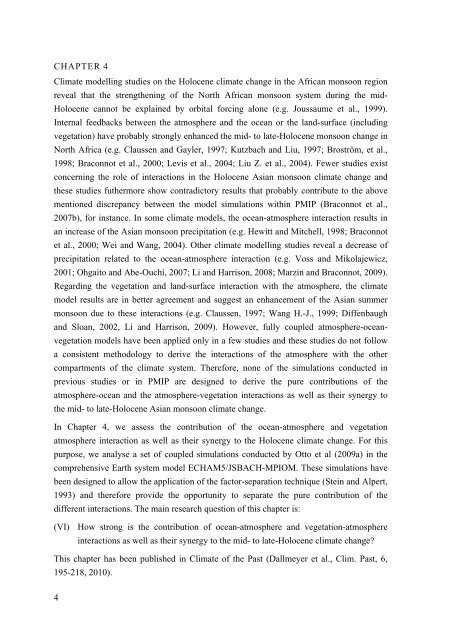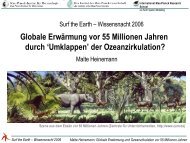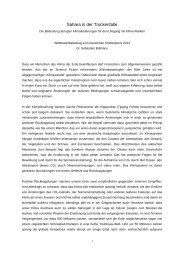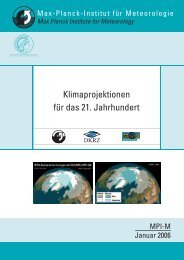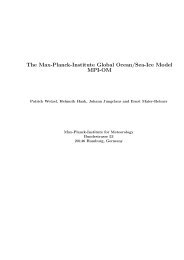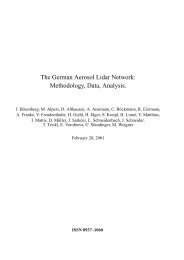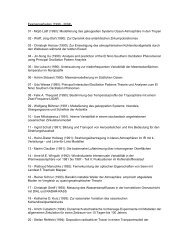Berichte zur Erdsystemforschung - Max-Planck-Institut für ...
Berichte zur Erdsystemforschung - Max-Planck-Institut für ...
Berichte zur Erdsystemforschung - Max-Planck-Institut für ...
You also want an ePaper? Increase the reach of your titles
YUMPU automatically turns print PDFs into web optimized ePapers that Google loves.
CHAPTER 4<br />
Climate modelling studies on the Holocene climate change in the African monsoon region<br />
reveal that the strengthening of the North African monsoon system during the mid-<br />
Holocene cannot be explained by orbital forcing alone (e.g. Joussaume et al., 1999).<br />
Internal feedbacks between the atmosphere and the ocean or the land-surface (including<br />
vegetation) have probably strongly enhanced the mid- to late-Holocene monsoon change in<br />
North Africa (e.g. Claussen and Gayler, 1997; Kutzbach and Liu, 1997; Broström, et al.,<br />
1998; Braconnot et al., 2000; Levis et al., 2004; Liu Z. et al., 2004). Fewer studies exist<br />
concerning the role of interactions in the Holocene Asian monsoon climate change and<br />
these studies futhermore show contradictory results that probably contribute to the above<br />
mentioned discrepancy between the model simulations within PMIP (Braconnot et al.,<br />
2007b), for instance. In some climate models, the ocean-atmosphere interaction results in<br />
an increase of the Asian monsoon precipitation (e.g. Hewitt and Mitchell, 1998; Braconnot<br />
et al., 2000; Wei and Wang, 2004). Other climate modelling studies reveal a decrease of<br />
precipitation related to the ocean-atmosphere interaction (e.g. Voss and Mikolajewicz,<br />
2001; Ohgaito and Abe-Ouchi, 2007; Li and Harrison, 2008; Marzin and Braconnot, 2009).<br />
Regarding the vegetation and land-surface interaction with the atmosphere, the climate<br />
model results are in better agreement and suggest an enhancement of the Asian summer<br />
monsoon due to these interactions (e.g. Claussen, 1997; Wang H.-J., 1999; Diffenbaugh<br />
and Sloan, 2002, Li and Harrison, 2009). However, fully coupled atmosphere-ocean-<br />
vegetation models have been applied only in a few studies and these studies do not follow<br />
a consistent methodology to derive the interactions of the atmosphere with the other<br />
compartments of the climate system. Therefore, none of the simulations conducted in<br />
previous studies or in PMIP are designed to derive the pure contributions of the<br />
atmosphere-ocean and the atmosphere-vegetation interactions as well as their synergy to<br />
the mid- to late-Holocene Asian monsoon climate change.<br />
In Chapter 4, we assess the contribution of the ocean-atmosphere and vegetation<br />
atmosphere interaction as well as their synergy to the Holocene climate change. For this<br />
purpose, we analyse a set of coupled simulations conducted by Otto et al (2009a) in the<br />
comprehensive Earth system model ECHAM5/JSBACH-MPIOM. These simulations have<br />
been designed to allow the application of the factor-separation technique (Stein and Alpert,<br />
1993) and therefore provide the opportunity to separate the pure contribution of the<br />
different interactions. The main research question of this chapter is:<br />
(VI) How strong is the contribution of ocean-atmosphere and vegetation-atmosphere<br />
4<br />
interactions as well as their synergy to the mid- to late-Holocene climate change?<br />
This chapter has been published in Climate of the Past (Dallmeyer et al., Clim. Past, 6,<br />
195-218, 2010).


